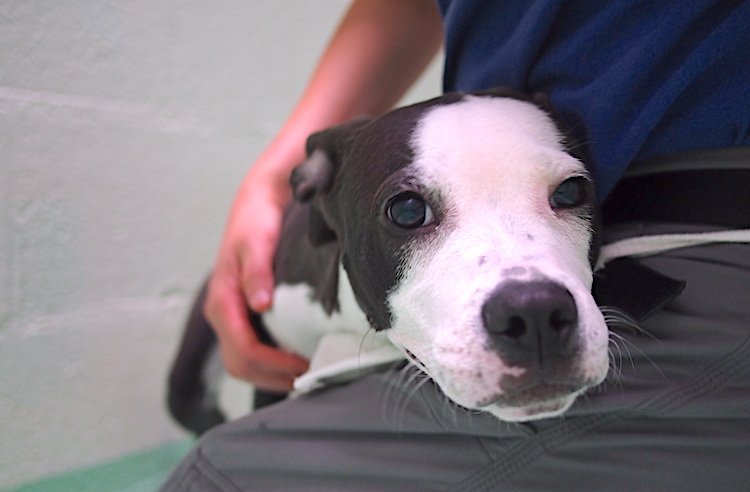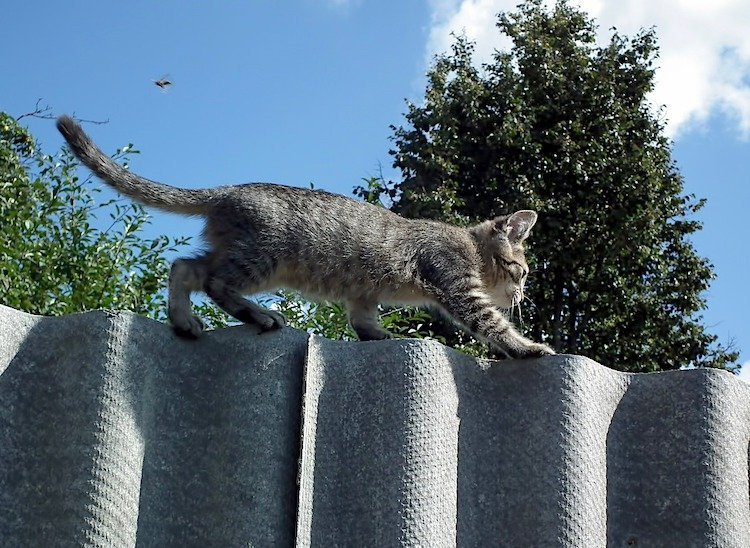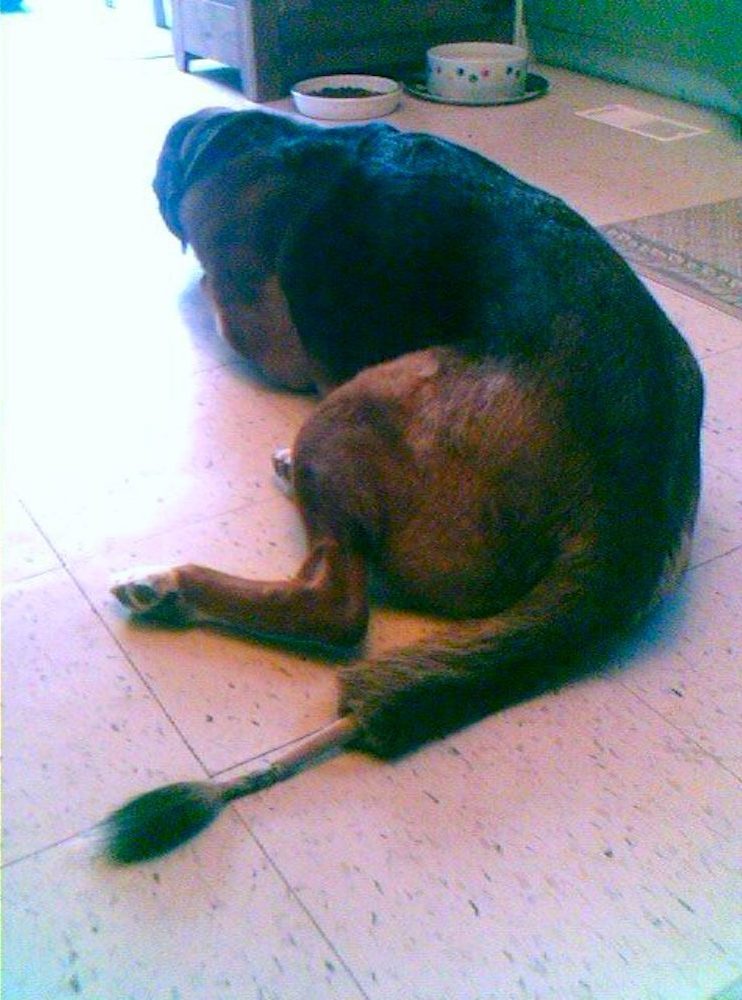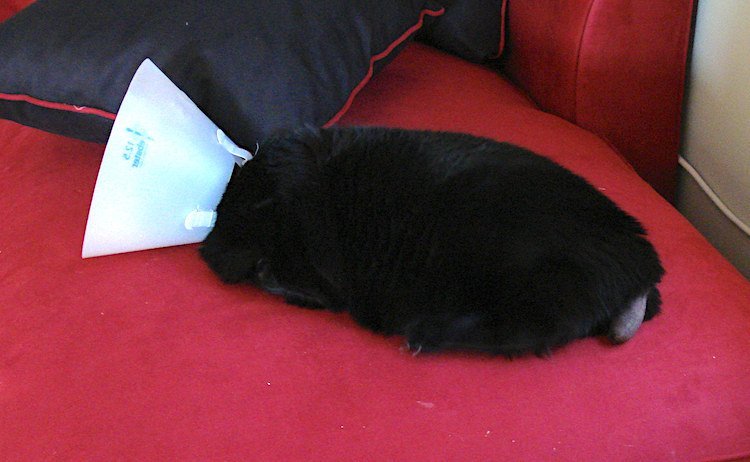[ad_1]
This pet health content was written by a veterinarian, Dr. Pippa Elliott, BVMS, MRCVS, with contributions from Dr. Phil Zeltzman, DVM, DACVS, CVJ, a board-certified veterinary surgeon. This article was last reviewed July 23, 2019.
If you have questions or concerns, call your vet, who is best equipped to ensure the health and well-being of your pet. This article is for informational purposes only and is not a substitute for professional medical advice, diagnosis or treatment. See additional information.
Petful may earn a commission if you click on our links and make a purchase. This comes at no extra cost to you and helps us continue providing trusted pet product reviews.
Tail injuries happen.
Whether your dog has “happy tail syndrome” or your cat’s tail has been crushed in a door, you may be facing tail amputation.
This may sound drastic, but most pets are back on their paws quickly and all the happier for no longer having a damaged tail.
Please note that we will not discuss tail docking in this article, as it is a controversial topic and is considered unethical by the American Veterinary Medical Association.
- Tail amputation is usually a medical necessity: It’s performed to treat severe injuries, infections, or tumors that can’t heal on their own.
- The procedure is done under anesthesia: Veterinarians remove the damaged portion of the tail while keeping recovery comfort and function in mind.
- Recovery requires proper care: Pain management, wound cleaning, and monitoring for infection are essential during healing.
- Most pets adapt quickly: Dogs and cats typically regain balance, comfort, and normal activity after recovery.
6 Common Reasons for Tail Amputation in Dogs and Cats
Tails serve important roles. They help cats communicate through body language and dogs express emotion and balance. So when a veterinarian recommends amputation, it is not a decision made lightly.
Here are some of the most common reasons why tail removal may be necessary:
- Severe injury or trauma: Broken, crushed, or deeply cut tails that cannot heal properly often require surgical removal.
- Infection or abscess: Persistent infections that do not respond to treatment can spread and make amputation the safest option.
- Tumors or growths: Cancerous or recurring masses at the base or along the tail sometimes need removal to prevent further spread.
- Chronic pain or nerve damage: When nerve injuries cause unrelenting discomfort, amputation can restore comfort and quality of life.
- Frostbite or poor circulation: In cold climates, tissue death or loss of blood flow may make saving the tail impossible.
- Repetitive trauma or happy tail syndrome: Some dogs injure their tails repeatedly by wagging against hard surfaces, leading to non-healing wounds
While it may sound drastic, tail amputation is often the kindest solution for a pet in pain. With proper pain management and recovery care, most dogs and cats adjust quickly and return to happy, comfortable lives.
Here are 6 common reasons tail amputation may be required:
1. Happy Tail Syndrome
The Labrador Retriever is often the poster dog for this condition. If they are awake, they are wagging sometimes so hard that it leads to injury.
Here is how happy tail syndrome develops and why it can become serious:
- Repeated impact: The tail hits hard or abrasive surfaces like brick, concrete, or metal, eventually breaking the skin.
- Persistent bleeding: Once the skin splits, blood can spray with every wag, creating a mess and delaying healing.
- Difficult bandaging: Dressings or wraps rarely stay in place because wagging shakes them loose.
- Itch and irritation: As wounds scab, dogs lick or chew the area, worsening the injury.
- Chronic non-healing wounds: Despite bandaging or topical care, some tails simply will not heal.
If the wound does not improve after diligent care, tail amputation may be necessary to end the pain and prevent infection. For more information, see VCA’s guide on tail injuries in dogs and this veterinary insight on managing chronic tail trauma.
2. Degloving Injuries
Degloving injuries happen when the skin and fur are peeled away from the tail bone, much like removing a glove from a hand. This type of trauma is extremely painful and often requires immediate veterinary attention.
Here is what you need to know about degloving injuries in pets:
- Common cause: These injuries usually occur after being caught in a door, hit by a car, or dragged on a rough surface.
- Serious exposure: The tail bone becomes visible and unprotected once the skin is stripped away.
- High infection risk: Open bone and tissue quickly attract bacteria, leading to severe infections.
- Limited healing options: Because the tissue cannot reattach, the damaged part of the tail often must be surgically removed.
Tail amputation in these cases helps prevent infection and allows the pet to heal comfortably. With prompt care, most dogs and cats recover well and adjust easily.
3. Crush Injuries
Crush injuries are common in cats and dogs, often caused by doors, gates, or heavy objects closing on the tail. Even a brief accident can lead to significant pain and tissue damage.
Here is what typically happens when a tail is crushed:
- Door or gate accidents: Many cases occur when a cat or dog walks through a doorway just as it closes.
- Soft tissue trauma: The tail may swell, bruise, or bleed internally even if bones remain intact.
- Fractures or dislocation: Severe crush injuries can break bones or disconnect vertebrae near the tail’s base.
- Nerve damage: In some cases, nerve function is lost, affecting the pet’s ability to move or feel the tail.
If the tail is too damaged to heal or causes chronic pain, amputation is often the kindest solution. Most pets recover quickly and live comfortably without it.
4. Traumatic Nerve Damage to the Bladder
Severe accidents that injure a cat’s pelvis or lower spine can sometimes damage the nerves controlling the tail and bladder. These cases require immediate veterinary evaluation.
Here is what happens when nerve damage affects the tail and bladder:
- Pelvic or spinal injury: Trauma from a fall or vehicle accident can stretch or tear the nerves connected to the tail and bladder.
- Limp or motionless tail: A completely limp tail often signals serious nerve involvement.
- Pulling on the spinal cord: The weight of a paralyzed tail can place additional strain on damaged nerves.
- Loss of bladder or bowel control: Ongoing nerve stress can lead to urinary or fecal incontinence if left untreated.
In these cases, tail amputation may help relieve pressure on the spinal cord and prevent further nerve damage. With early intervention, some nerve function may return and pets can still lead comfortable lives.
5. Phantom Pain and Tail Obsessions
Sometimes, the nerves in a pet’s tail continue to send pain signals long after an injury has healed. This lingering sensation, called phantom pain, can cause serious distress and self-harm.
Here is what happens when pets experience phantom pain or tail obsession:
- Nerve memory: Damaged nerves may continue firing pain signals even after the original wound is gone.
- Self-inflicted injury: Some pets bite, chew, or attack their own tails, mistaking them for the source of pain.
- Obsessive behavior: The cycle of pain and reaction can turn into a compulsive habit that worsens over time.
- Emotional distress: Anxiety and confusion can make recovery even harder for affected animals.
In rare cases, tail amputation becomes a last-resort treatment to end the cycle of pain and self-trauma. Proper pain management and early intervention can help prevent escalation. Read more about phantom pain in small animals and the importance of rescue care through the RSPCA
6. Tail Tumors
Because the skin on a pet’s tail is thin and tight, there is little extra tissue to close a surgical site. This makes tumor removal more complicated than on other parts of the body.
Here is what you should know about tail tumors:
- Limited skin coverage: The tail has very little spare skin, so large masses are difficult to remove without leaving an open wound.
- Benign or malignant growths: Some tumors are harmless, but others, such as mast cell tumors, can spread and require aggressive treatment.
- Surgical challenges: When there is not enough tissue to close the area safely, partial or full tail amputation may be the best option.
- Positive outcomes: Most pets recover well and experience relief once the tumor and pain are gone.
Learn more about mast cell tumors in dogs and how early detection can improve treatment success.
Recommended Post-Surgery Supplies for Dogs and Cats
Helping your pet recover comfortably after tail amputation requires a few essential supplies.
Learn more about these products in our full editorial spotlights on Lazarus Naturals and MetLife Pet Insurance.
Tail Amputation Alternatives
The vet will try hard to salvage the tail, before advising for amputation.
Typically, this involves assessing the extent of the injuries by:
- Radiographs to check for crushed bones
- Examining skin wounds under sedation or anesthesia
- Managing wounds with dressing, antibiotics and pain relief
- Preventing self-trauma with an E collar
However, not all cases respond.
And sadly, for those dogs or cats who are left with irreparable damage or who fail to respond, tail amputation is for the best.
This is because the tail is the end part of the spine, so it is full of nerves, and all of these injuries can cause significant pain.
When the wounds cannot be repaired or will not heal, or when the bandage stubbornly falls off, or when a dog wags their tail so hard that the tail keeps getting re-injured, then we may have to resort to tail amputation.
Preventing Phantom Pain After Tail Amputation
If the injury is painful, a wise vet gets on top of the pain before amputating. This can mean anything from giving a powerful painkiller with the pre-med, through to several days of pain-relieving medication before surgery is considered.
The reason this is important is to stop “nerve memory.”
This phenomenon was recognized after World War II, when pilots complained of ongoing pain in amputated limbs, long after surgery. The importance of removing pain ahead of removing the limb came to light and remains good practice.
To do this may require a cocktail of medications to really get on top of things. But this is a good investment in the pet’s future well-being.
In addition, the vet may want to get infection under control (although this isn’t always necessary) before going ahead.
Tail Amputation Surgery: What to Expect
For the majority of dogs and cats, tail amputation is day surgery — meaning they can go home that evening. (The exceptions are those patients with complications, such as trauma after a traffic accident).
As with most surgical procedures, you’ll need to forgo feeding your pet overnight, so they have an empty stomach ready for the anesthetic.
Not all tails have to be taken to a short stump, with some being salvaged to a length where the dog can still wag or the cat can still use it for balance. Usually the vet will let you know ahead of time how much will be removed.
Tail amputation requires a full general anesthetic and takes 20–40 minutes, depending on how high up the amputation is. The vet may place absorbable sutures, which dissolve on their own, so there’s less fiddling around when healing is complete.
Sometimes the remaining tail is bandaged, or it may be left open to the air. If the patient is able to reach the surgical site, then an E collar is a good idea to stop them from licking or chewing the wound.
The pet may look a little strange to you at first, because they’ll have hair shaved around the tail base and have a new silhouette. However, once the fur grows back, the stump can look super-cute, like a furry bobtail.
Your pet may have a post-op check 2–3 days later. This is when the vet makes sure the pet has recovered from the anesthetic and is eating normally. They’ll also check the area for infection and pain, and then supply any appropriate medications.
Healing is usually complete after 10–14 days, which is when any non-absorbable sutures will need to come out.
For much more information, see “Your Pet’s Surgery: An Expert Guide to What to Expect.”
Here’s a Bulldog who has undergone a medically necessary tail amputation:
What to Expect in the Long Term
If you’re worried about how your pet will cope without a tail, please don’t be.
The vast majority of dogs and cats never look back — indeed, they seem far happier afterward because they are no longer in pain:
- Yes, cats do use their tail for balance, but they soon compensate and adapt. During this period, it’s good to keep outdoor cats indoors so they can find their footing in a relatively safe environment. After that, they can usually get up to all their old tricks again.
- As for dogs, yes, they do use their tail for communication. In theory, this could make it more difficult for a strange dog to read your pup’s body language. When other people are responsible and keep their dogs under control, this shouldn’t cause a problem.
So, although tail amputation isn’t something you would ever wish on your pet, know that you are probably more anxious about it than they are.
Don’t worry: Like any other pet amputees, they will most likely adapt and quickly be back to their usual happy self.
Frequently Asked Questions (FAQ)
How long does a cat tail amputation take to heal?
A cat’s tail amputation typically takes about 10 to 14 days to heal, depending on the extent of surgery and post-op care.
How long does a tail amputation take to heal?
Most tail amputations heal within 2 weeks, though full recovery may take longer if there are complications or infections.
How much is a dog tail amputation?
A dog tail amputation usually costs between $300 and $800, depending on the clinic, anesthesia, and aftercare needs.
References
- “Ear Cropping and Tail Docking of Dogs.” American Veterinary Medical Association. https://www.avma.org/KB/Policies/Pages/Ear-Cropping-and-Tail-Docking-of-Dogs.aspx.
- Walker, C., et al. “Balance in the Cat: Role of the Tail and Effects of Sacrocaudal Transection.” Behavioural Brain Research 91, no. 1–2 (March 1998): 41–47. https://pubmed.ncbi.nlm.nih.gov/9578438/.
- Johnson-Bennett, Pam. “Your Cat’s Tail: What it Says About Her Mood.” Cat Behavior Associates. 2016. https://www.catbehaviorassociates.com/your-cats-tail-what-it-says-about-her-mood/.
- Reimchen, Thomas, DPhil, and Stephen Leaver. “Behavioural Responses of Canis Familiaris to Different Tail Lengths of a Remotely-Controlled Life-Size Dog Replica.” Behaviour 145, no. 3 (Jan. 1, 2008): 377–390. https://brill.com/view/journals/beh/145/3/article-p377_7.xml.
- Coren, Stanley, PhD, DSc, FRSC. “Why Do Dogs Have Tails?” Psychology Today. Nov. 24, 2016. https://www.psychologytoday.com/us/blog/canine-corner/201611/why-do-dogs-have-tails.
- Buzhardt, Lynn, DVM. “Tail Injuries in Dogs.” VCA Hospitals. 2015. https://vcahospitals.com/know-your-pet/tail-injuries-in-dogs.
- Johnson, Tony, DVM, DACVECC. “The Infinite Sadness of Happy Tail.” VetzInsight from Veterinary Partner and VIN. Sept. 14, 2015. https://www.vin.com/vetzinsight/default.aspx?pid=756&catId=5860&id=6998567.
- Hattersley, Rachel, BVetMed, CertSAS, DipECVS, MRCVS. “Management of Canine and Feline Degloving Injuries.” Vet Times. Oct. 1, 2018. https://www.vettimes.co.uk/article/management-of-canine-and-feline-degloving-injuries/.
- Brooks, Wendy, DVM, DABVP. “Broken Tails in Cats Aren’t Always Obvious.” Veterinary Partner. Nov. 25, 2002. https://veterinarypartner.vin.com/default.aspx?pid=19239&catId=102903&id=4951820.
- Pendergrass, JoAnna, DVM. “New Insights Into the Phantom Complex for Small Animals.” American Veterinarian. Jan. 4, 2008. https://www.americanveterinarian.com/news/new-insights-into-the-phantom-complex-for-small-animals.
- Menchetti, Marika, DVM, PhD, et al. “Approaching Phantom Complex After Limb Amputation in the Canine Species.” Journal of Veterinary Behavior 22 (November–December 2017): 24–28. https://www.sciencedirect.com/science/article/abs/pii/S1558787817300904.
- Herold, Lee, DVM, DACVECC. “Caudectomy in the ER.” DoveLewis Emergency Animal Hospital. https://www.atdove.org/article/caudectomy-in-the-er.
[ad_2]






